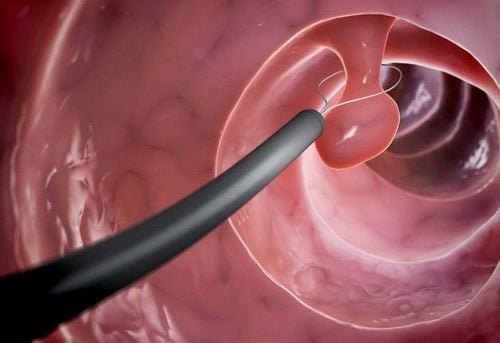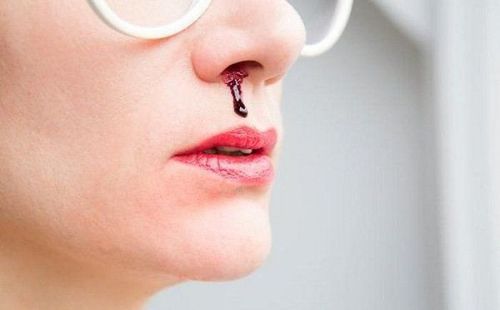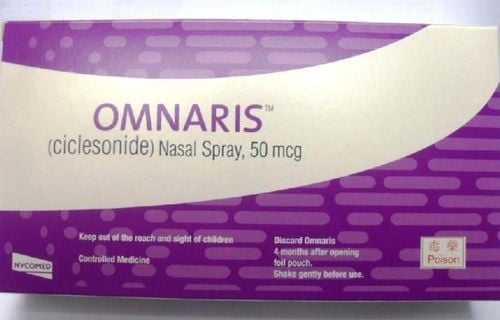This is an automatically translated article.
Nosebleed is a common complication that can be caused by many causes such as pathology, trauma with different severity levels. Accordingly, if the patient is not treated promptly, the nosebleed can seriously affect the health as well as the quality of life later on.
1. Causes of nosebleed
The nasal mucosa has a dense network of capillaries, very shallow to perform the task of warming and humidifying the air before entering the lungs. Therefore, even a minor injury like picking or bumping the nose can cause a nosebleed. Some of the main causes of nosebleeds are:
Surgical causes: Nosebleeds due to trauma in wartime and peacetime such as stab wounds, labor accidents, traffic accidents, bullets... Internal medicine: Patients with a history of diseases such as: High blood pressure, blood diseases, dengue fever, liver failure, chronic kidney failure can cause nosebleeds.
2. Levels of nosebleed
There are 3 types of nosebleed as follows:
Kisselbach pulse point bleeding; Bleeding due to damage to the arteries; Diffuse bleeding due to damage to capillaries, oozing blood throughout the nasal mucosa, unspecified often occurs in acute myeloid leukemia, hemophilia, typhoid, and dengue fever. Accordingly, based on the degree of nosebleed, medical experts evaluate nosebleed status according to 3 levels: mild, moderate and severe.

Có 3 loại chảy máu mũi
2.1. Mild nosebleeds Mild nosebleeds are usually caused by minor trauma such as nose picking or by illnesses such as flu, typhoid, etc. However, some healthy people can naturally have nosebleeds. . Nasal examination shows blood flowing from the pulse point or artery but not much, dripping with the amount of less than 100ml and tends to stop on its own. This type of nosebleed is often called a nosebleed and is common in children with a mild prognosis.
2.2. Nosebleeds Both nosebleeds are the phenomenon of blood flowing out of the nostrils or down the throat, the amount is about 100-200ml. Possibly due to capillary bleeding of the entire nasal mucosa.
2.3.Heavy nosebleeds Heavy nosebleeds are often caused by damage to the nasal arteries with patients with a history of diseases such as hypertension, atherosclerosis, cirrhosis of the liver... cause patient irritation, panic, pale lips, low blood pressure, blood loss more than 200ml is common in elderly patients with chronic diseases or because of trauma causing damage to the ethmoid artery and often bleeding. tricky. In this case, nasoposcopy is difficult because the discharge point is usually high and posterior, but the bleeding is large.

Mất nhiều máu khiến huyết áp bệnh nhân bị tụt mạnh
3. First aid for nosebleeds
When you see a patient with a nosebleed, the first thing to do is stop the bleeding. The patient may be instructed to sit forward to prevent blood from entering the throat. Accordingly, if the nosebleed is severe, it is necessary to pay attention to the patient's whole body condition by closely monitoring the pulse and measuring blood pressure.
3.1 First aid for minor nosebleeds If the nosebleed is light from the pulse point, the first-aider uses two fingers to squeeze the wings of the nose while clenching the hand so that the Kisselbach point is pressed to stop the bleeding, to prevent the blood from continuing to flow. Next, use cotton soaked in hemostatic solution such as 12 volume hydrogen peroxide, 1-3% ephedrine inserted into the nostrils, pressing on the bleeding site.
3.2. First aid for a lot of nosebleeds If the patient has a lot of nosebleeds, it is necessary to use active measures as follows:
Method of placing nose tea first
Instruments: clar light, elbow fork, nose opener, tongue depressor, wick 1.5cm wide, 40cm long, gloved fingers. Medicines: Paraffin oil, 6% cocaine numbing medicine, rubber bags (capsule or gloved fingers). Procedure: First, instruct the patient to blow all the blood in the nose, and at the same time place a 10cm long piece of cocaine soaked wick in the nose, this has the effect of reducing pain and vasoconstriction during the procedure. After about 3 minutes, the doctors can withdraw the cocaine wick, use a nasal opener to widen the nostrils close to the inside of the nasal cavity to see if the patient has a crest septum or deviated septum for the purpose of conducting the procedure. poke the nose, avoid causing the patient to have more nosebleeds. Next, inject antibiotic ointment or paraffin oil into the nasal cavity, then insert the rubber bag to open the nose, continue to put the rubber bag in the nose. Use an elbow fork to insert the wick into the nasal cavity through the opening of the nose to a depth of 6-8cm, continue to insert the wick into the nasal cavity, starting at the top and bottom, then inside before, out back to the nostril. The wicks are arranged in a zigzag pattern. While inserting the nose wick, it should be tight so that the gap does not die. Examination of the back of the pharynx does not show blood flowing down the throat, which is satisfactory.
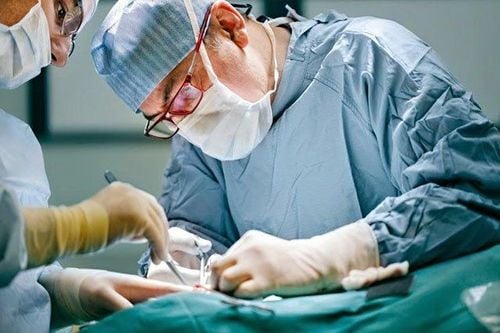
Phương pháp đặt mechè mũi trước
Should not leave the wick for more than 48 hours, but need to proceed to withdraw the wick, however when removing the wick, the wicks should be withdrawn slowly in a lying position, Y or the doctor pulls the wick out slowly, one at a time, each segment does not exceed 5 cm, after each pause for 5 minutes, while withdrawing and instilling hydrogen peroxide into the nose. Draw the wick for a period of 20 to 30 minutes.
Posterior nasal septum method
If in case the patient has nosebleeds due to lesions behind and above the nasal cavity or anterior nasal septum has been placed but it is not effective, then it is necessary to apply the posterior rhinoplasty procedure.
Tools: In addition to the tools used to place the anterior nasal meche, when performing the posterior rhinoplasty, it is necessary to add a small rubber Nelaton tube, a cylindrical gauze with a diameter of about 3cm and a height of about 3cm tied to a strong thread. 25cm long, a second gauze is cylindrical but 1cm smaller in diameter. Method: Place the Nelaton tube in the patient's nostril on the bleeding side and push the tube down the throat. Instruct the patient to open the mouth, and at the same time use the pliers to pull the Nelaton head out of the mouth. Tie one end of the gauze thread to the tip of the Nelaton tube. Pull the Nelaton tube backwards from the throat to the nose. The gauze is pulled back by the thread from the pharynx to the nasopharynx and into the posterior nasopharynx. When the gauze goes through the isthmus, it often gets stuck, so the doctor can use the index finger of the right hand to push the gauze up and behind to overcome the narrow waist. The left hand continues to hold the Nelaton tube and pulls the thread forward. Finally, remove the thread from the rubber tube and tie it to a second gauze, which seals the front nostril. If the posterior and anterior nasopharynx are inserted but the nosebleed is still present, ligation of the internal maxillary artery in the sphenoid fossa or the anterior and posterior ethmoid arteries should be ligated at the medial border of the orbit.
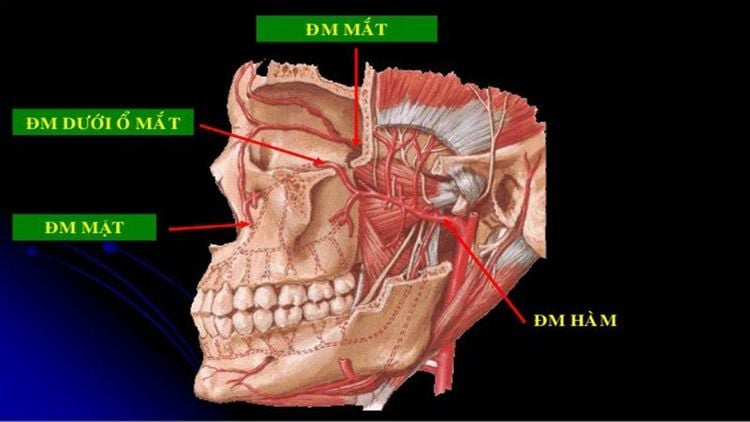
Cần thắt các động mạch nếu máu vẫn còn chảy
During treatment, patients with nosebleeds need to rest, lay their heads up to breathe and spit out blood. Administer intravenous fluids if the patient has a pulse or low blood pressure. Blood transfusion is possible if the Hb is less than 50%, but it is best to transfuse small doses of fresh blood in several times. Use corticosteroids such as depersolone intravenously for bleeding, unless contraindicated. In addition, use antibiotics to prevent infections and use blood thinners to strengthen the vessel wall, reduce bleeding time or directly clot the blood, for example vitamin K...
International General Hospital Vinmec is a general hospital with the function of examining and treating ENT diseases and many other diseases. At Vinmec, we have also performed endoscopic diagnosis and treatment with modern medical methods for ear, nose and throat diseases, which not only brings high efficiency but also minimizes complications of recurrent disease. On the other hand, in order to improve service quality, Vinmec is now fully equipped with modern facilities, examination and treatment procedures performed by a team of experienced and qualified doctors. optimal treatment results for customers.
To register for medical examination and treatment at Vinmec International General Hospital, you can contact Vinmec Health System nationwide, or register online HERE.





